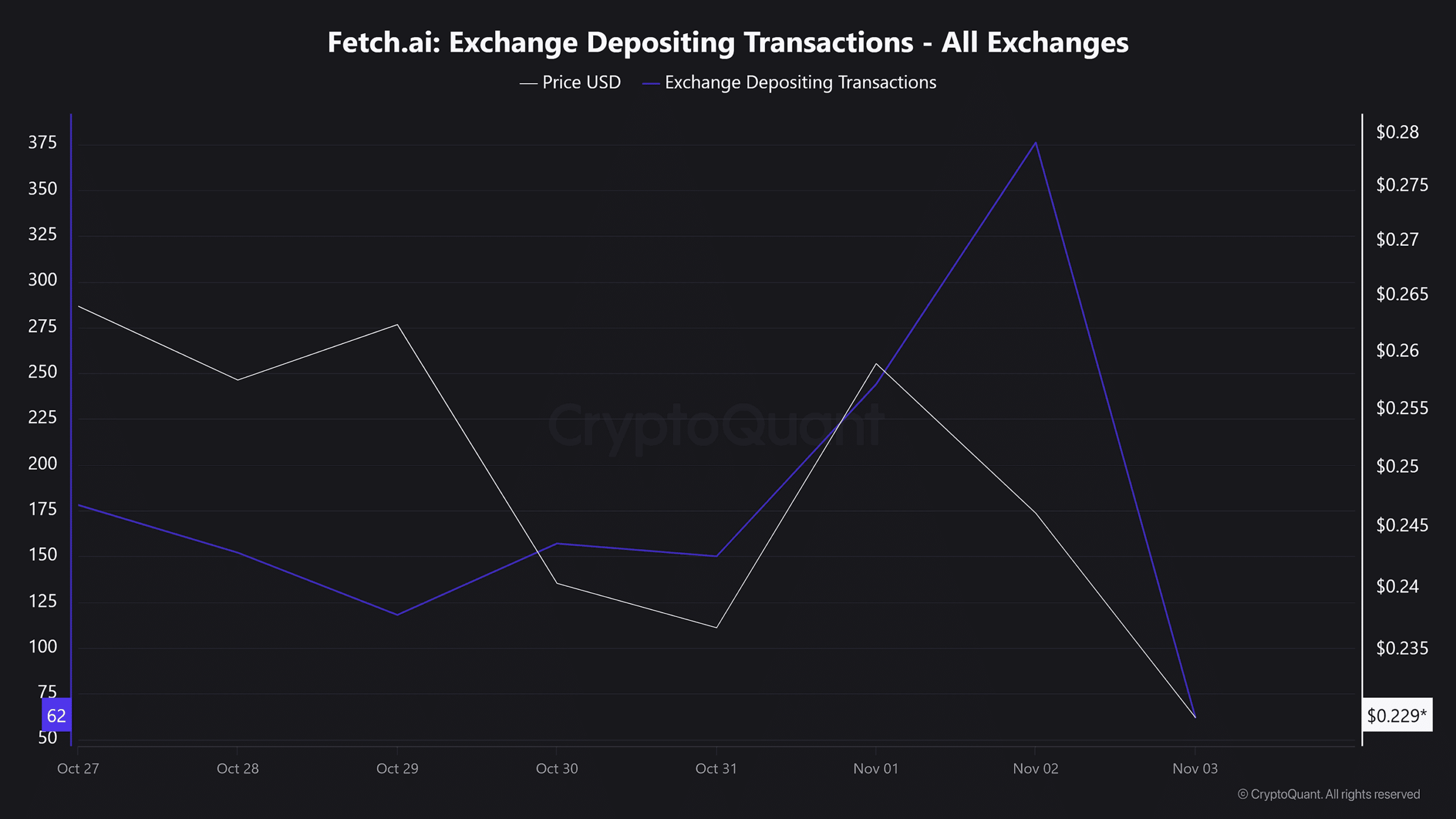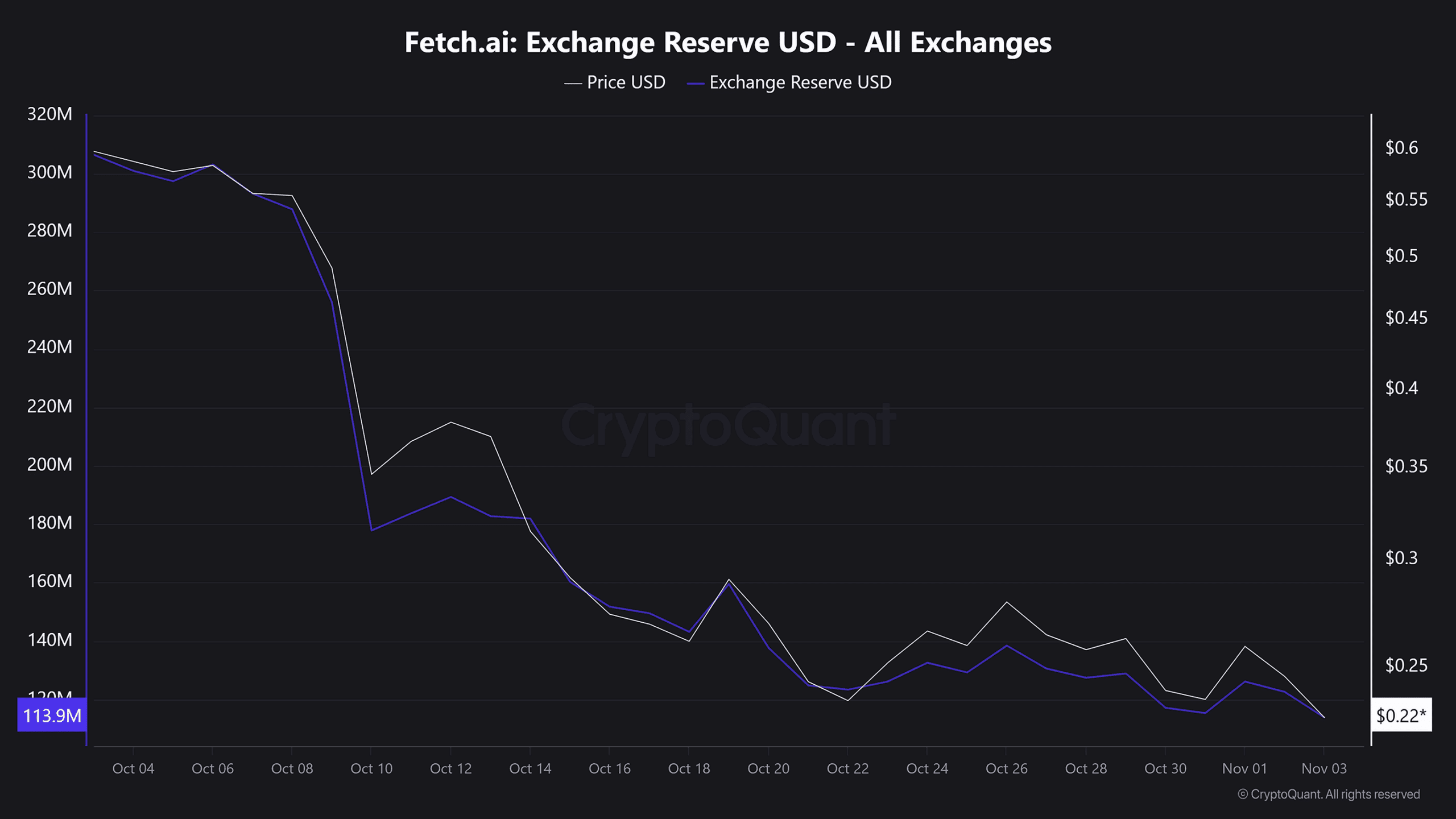Fetch.ai (FET) is under pressure due to declining exchange reserves and dominant short positions, with the token dropping 13% to $0.229 amid weak investor confidence and reduced trading activity since late October 2025.
-
Exchange reserves for FET fell from $300 million to $113.9 million, indicating liquidity pullback and low demand.
-
Long/short ratio at 0.83 shows shorts controlling 54.74% of open interest, fueling bearish momentum below $0.23.
-
Depositing transactions have steadily declined, reflecting trader hesitation rather than accumulation in the current market weakness, with data from CryptoQuant highlighting a 62% reserve drop by November 3, 2025.
Discover why Fetch.ai (FET) price is dropping amid bearish signals. Exchange reserves plummet, shorts dominate—explore key factors and future outlook for FET investors today.
Why is Fetch.ai (FET) Under Pressure?
Fetch.ai (FET) is experiencing significant downward pressure primarily due to shrinking exchange reserves and a surge in short positions, leading to a 13% price decline over the past 24 hours to around $0.229 as of November 3, 2025. This bearish trend stems from reduced trader activity and waning confidence in AI-linked tokens, with sellers maintaining control after failed rallies above $0.26. Broader market hesitation has amplified the vulnerability, preventing any meaningful recovery.
What Factors Are Driving FET’s Declining Exchange Activity?
Analysis from CryptoQuant reveals that FET’s exchange depositing transactions have been on a consistent downtrend since late October 2025, pointing to diminished liquidity on trading platforms. While decreased deposits can occasionally signal long-term holding, in this context, they align with overall market softness, suggesting investors are pausing rather than building positions. This lack of inflow exacerbates the price stagnation, as potential buyers await clearer signals from the AI sector.

Source: CryptoQuant
CryptoQuant’s data on exchange reserves further underscores this trend, with FET balances dropping sharply from $300 million in early October to just $113.9 million by November 3, 2025—a reduction of over 62%. Normally, such outflows might indicate accumulation by long-term holders moving assets to secure wallets, but the simultaneous price erosion tells a different story. Here, the decline points to disengagement, where tokens are withdrawn without corresponding demand to support values, leaving FET exposed to further selling.
Experts in blockchain analytics, such as those cited in reports from CryptoQuant, note that this pattern often precedes prolonged consolidation in volatile assets like FET. The absence of robust inflows means that any residual sell orders can push prices lower, contributing to the current bearish environment. As AI tokens face scrutiny amid broader crypto market fluctuations, FET’s reserve dynamics highlight the need for renewed institutional interest to reverse the tide.

Source: CryptoQuant
In the Artificial Superintelligence Alliance ecosystem, where FET plays a central role, these metrics reflect broader challenges. The platform’s focus on decentralized AI solutions has garnered attention, but recent tokenomics shifts and market volatility have deterred short-term traders. Data indicates that without a catalyst, such as positive developments in AI adoption or regulatory clarity, the reserve drain could persist, weighing on FET’s valuation.
Frequently Asked Questions
What is causing the recent 13% drop in Fetch.ai (FET) price?
The 13% decline in Fetch.ai (FET) price to $0.229 stems from plummeting exchange reserves and heightened short selling, as reported by on-chain analytics platforms. Traders have withdrawn liquidity amid low confidence, with no strong buying to counter the bearish push, leading to sustained downward momentum since late October 2025.
How does the long/short ratio impact FET’s trading sentiment?
The long/short ratio for FET standing at 0.83, with shorts at 54.74% of open interest, creates a bearish tilt that keeps prices pinned below key resistance levels like $0.23. This setup, as observed in derivatives markets, amplifies selling pressure and could lead to increased volatility if liquidations spike, spoken naturally in voice searches for current FET trends.
Key Takeaways
- Declining Exchange Reserves: FET reserves fell 62% to $113.9 million, signaling trader disengagement rather than accumulation in a weak market.
- Short Positions Dominate: With 54.74% shorts in open interest per CoinGlass data, bearish bias holds firm, suppressing price recovery attempts.
- Weak Demand Ahead: Monitor for AI sector catalysts; without them, FET risks testing $0.20 support for potential stabilization.
FET Exchange Activity Signals Weak Demand
Building on the reserve trends, FET’s on-exchange behavior points to a broader liquidity crunch. Depositing transactions, tracked via CryptoQuant, have tapered off markedly, reducing the volume of FET available for immediate trading. This isn’t isolated; similar patterns appear across AI tokens, where enthusiasm peaked earlier in the year but has since evaporated due to macroeconomic headwinds and profit-taking.
In professional circles, analysts emphasize that such low activity often correlates with heightened risk aversion. For FET, integrated into the Artificial Superintelligence Alliance, the token’s utility in autonomous economic agents remains promising, yet real-world adoption lags behind hype. Without fresh inflows, the current setup favors caution for investors eyeing short-term trades.
Shorts Dominate the Market
Derivatives data from CoinGlass illustrates the extent of bearish positioning, with the long/short ratio dipping to 0.83 on November 3, 2025. This means for every dollar in long bets, shorts outpace by nearly 20%, capturing over half of total open interest. Such dominance not only reflects pessimism but also sets the stage for cascading effects if prices nudge higher, triggering short liquidations.

Source: CoinGlass
A ratio persistently below 1.0 underscores the challenges for bullish reversals. In FET’s case, this imbalance coincides with thinning order books, where even moderate sell volumes can drive outsized price swings. Market participants, including hedge funds focused on crypto derivatives, view this as a defensive stance amid uncertainties in the AI narrative.
What’s Next for FET?
Technical indicators remain unconvincing for a near-term rebound, with the Stochastic RSI in oversold territory yet showing no bullish divergence. FET’s price action mirrors the AI token sector’s cooldown from October 2025 peaks, where hype around decentralized intelligence drove gains but couldn’t sustain against global risk-off sentiments. Potential support at $0.20 looms if selling persists, though a shift toward accumulation could stabilize around current levels.
Looking ahead, FET’s trajectory hinges on ecosystem milestones within the Artificial Superintelligence Alliance. Developments like enhanced agent interoperability or partnerships could reignite interest, but for now, the data paints a picture of caution. Investors should track reserve metrics and sentiment shifts closely, as volatility in AI cryptos often precedes sharp moves.
Conclusion
In summary, Fetch.ai (FET) faces mounting pressure from depleted exchange reserves, dominant short positions, and subdued trading activity, as evidenced by CryptoQuant and CoinGlass metrics through early November 2025. These factors have driven the token’s price to $0.229, underscoring the need for stronger demand signals in the AI token space. As market dynamics evolve, staying informed on FET’s fundamentals positions investors for informed decisions—consider monitoring on-chain data for signs of reversal and potential recovery in the coming weeks.
